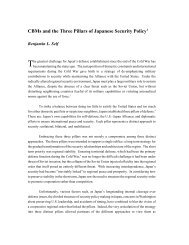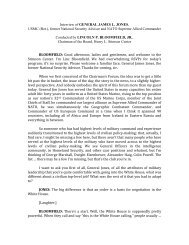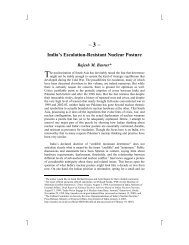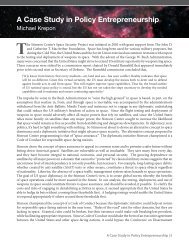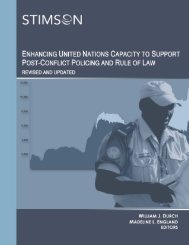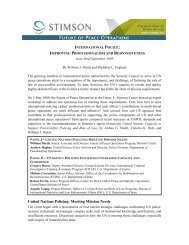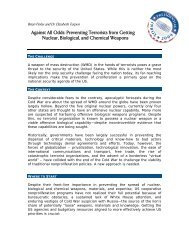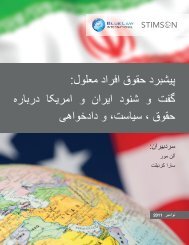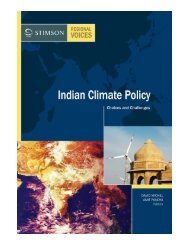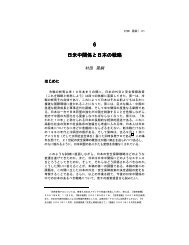Islam and Politics - The Stimson Center
Islam and Politics - The Stimson Center
Islam and Politics - The Stimson Center
Create successful ePaper yourself
Turn your PDF publications into a flip-book with our unique Google optimized e-Paper software.
46 | Ethnoreligious <strong>and</strong> Political Dimensions of the Southern Thail<strong>and</strong> Conflict<br />
<strong>The</strong> annexation was further strengthened in 1909 by an Anglo-Siamese treaty that drew<br />
a border between Pattani <strong>and</strong> the Malay states of Kedah, Kelantan, Perak, <strong>and</strong> Perlis.<br />
According to this treaty, the British recognized Siam sovereignty over Pattani. In return,<br />
Siam gave up its territorial claim over Kelantan <strong>and</strong> recognized British control over the<br />
other Malay states of Kedah, Perak, <strong>and</strong> Perlis.<br />
After 1909, Siam embarked on a centralization policy, which led to the imposition of Thai<br />
administrative officials in the three deep southern Malay provinces. Most of these officials<br />
were Thai Buddhists <strong>and</strong> unfamiliar with the local language <strong>and</strong> Muslim culture, which led<br />
to social antagonism.<br />
According to the centralization policy, the former negara Patani state was divided into<br />
three provinces— Narathiwat, Pattani, <strong>and</strong> Yala—which now make up the three Malay<br />
Muslim majority provinces of the South. This period also saw the beginning of the Pattani<br />
separatist movement, which was initially a royalist movement led by Tengku Mahmud<br />
Mahyuddin, a prominent Pattani leader <strong>and</strong> the son of the last raja of Pattani.<br />
<strong>The</strong> era of World War II (1939–45) witnessed the beginning of the Pattani nationalist<br />
movement. Led by Haji Sulong, it was put down by the central Thai authorities. During<br />
the 1970s, the resistance evolved into a nationalist irredentism, <strong>and</strong> has become a form of<br />
ethnoreligious nationalism with a strong emphasis on Malay Muslim ethnic <strong>and</strong> religious<br />
identity.<br />
<strong>The</strong> separatist movement in Southern Thail<strong>and</strong> seeks to sever the Malay region from the rest<br />
of the country, although official autonomy is an acceptable option. Over the last 50 years,<br />
numerous political groups <strong>and</strong> movements formed to support this cause, but the present<br />
insurgency is largely faceless. No single group has come out in recent years to claim leadership.<br />
3 <strong>The</strong> insurgents have blended into the local population, <strong>and</strong> it is said that they have<br />
a plan to resurface later, once they have gained enough strength on the ground <strong>and</strong> more<br />
support in local communities.<br />
3<br />
<strong>The</strong>se groups were: the Association of Malays of Greater Patani (GAMPAR), the Patani People’s Movement<br />
(PPM), the Barisan Nasional Pembebasan Patani (BNPP), the Barisan Revolusi Nasional (BRN), the<br />
Patani United Liberation Organization (PULO), <strong>and</strong> the Barisan Bersatu Mujahideen Patani (BBMP). During<br />
the 1980s to 1990s, new groups emerged, including the BRN-C, which is suspected of being behind the<br />
current insurgency along with many other factions; most of them are filled by youth who are independent<br />
of former separatist groups such as the PULO. <strong>The</strong>re is also the presence of the Gerakan Mujahidin <strong>Islam</strong><br />
Patani (GMIP), established by Afghan veterans in 1995, <strong>and</strong> Bersatu, or New PULO, an offshoot of the former<br />
PULO. Source: International Crisis Group, “Southern Thail<strong>and</strong> Insurgency, Not Jihad,” p. i, available at<br />
www.crisisgroup.org/library/documents/asia/south_east_asia/098_southern_thail<strong>and</strong>_insurgency_not_jihad.pdf;<br />
accessed January 24, 2009. See also International Crisis Group, “Southern Thail<strong>and</strong>: <strong>The</strong> Impact of the<br />
Coup,” Asia Report No. 129 (2007), p. 6, available at www.crisisgroup.org/library/documents/asia/south_<br />
east_asia/129_southern_thail<strong>and</strong>___the_impact_of_the_coup_web.pdf; accessed January 24, 2009.



